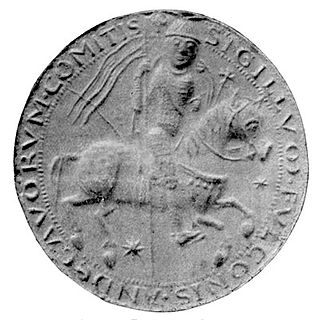This page is based on this
Wikipedia article Text is available under the
CC BY-SA 4.0 license; additional terms may apply.
Images, videos and audio are available under their respective licenses.

Anjou is a historical province of France straddling the lower Loire River. Its capital was Angers and it was roughly coextensive with the diocese of Angers. It bordered Brittany to the west, Maine to the north, Touraine to the east and Poitou to the south. The adjectival form of Anjou is Angevin, and inhabitants of Anjou are known as Angevins. During the Middle Ages, the County of Anjou, ruled by the Counts of Anjou, was a prominent fief of the French crown.

Geoffrey V —called the Handsome or the Fair and Plantagenet—was the Count of Anjou, Touraine, and Maine by inheritance from 1129 and then Duke of Normandy by conquest from 1144. By his marriage to the Empress Matilda, daughter and heiress of Henry I of England, Geoffrey had a son, Henry Curtmantle, who succeeded to the English throne as King Henry II (1154–1189) and was the first of the Plantagenet dynasty to rule England; the name "Plantagenet" was taken from Geoffrey's epithet. His ancestral domain of Anjou gave rise to the name Angevin for three kings of England, and what became known as the Angevin Empire in the 12th century.

Fulk, also known as Fulk the Younger, was the Count of Anjou from 1109 to 1129 and the King of Jerusalem from 1131 to his death. During his reign, the Kingdom of Jerusalem reached its largest territorial extent.

Fulk III, the Black was an early Count of Anjou celebrated as one of the first great builders of medieval castles. It is estimated Fulk constructed approximately 100 castles, along with abbeys throughout the Loire Valley in what is now France. He fought successive wars with neighbors in Brittany, Blois, Poitou and Aquitaine and made four pilgrimages to Jerusalem during the course of his life. He had two wives and three children.
Fulk II of Anjou, called le Bon was Count of Anjou from 942 to his death.
Geoffrey IV, called Martel, was Count of Anjou from 1103 until his early death, either co-ruling with his father, Fulk IV, or in opposition to him. He was popular with the Church and grew a reputation for curbing tyranny and opposing his violent father, who, according to Orderic Vitalis, enjoyed pillaging and terrorising his subjects.
Ermengarde of Anjou, was a Duchess consort of Burgundy. She was the daughter of Count Fulk III of Anjou and Hildegarde of Sundgau. She was sometimes known as Ermengarde-Blanche.

Adele of Meaux was a French noblewoman. She was Countess of Chalon and later Countess of Anjou.
Herbert I, called Wakedog, was the count of Maine from 1017 until his death. He had a turbulent career with an early victory that may have contributed to his later decline.
Ermengarde or Erembourg of Maine, also known as Erembourg de la Flèche, was Countess of Maine and the Lady of Château-du-Loir from 1110 to 1126. She was the daughter of Elias I, Count of Maine, and Mathilda of Château-du-Loire.
Ermengarde-Gerberga of Anjou, also called Ermengarde of Anjou, was the Countess of Rennes, Regent of Brittany (992–994) and also Countess of Angoulême.
William Taillefer, numbered William II or William IV, was the Count of Angoulême from 987. He was the son of Count Arnald II Manzer and grandson of Count William Taillefer I. He stood at the head of the family which controlled not only the Angoumois, but also the Agenais and part of Saintonge. By the time of his death he was "the leading magnate in [the west] of Aquitaine[, but his] eminence ... proved temporary and illusory," evaporating on his death in succession squabbles, revolts and the predations of his erstwhile allies. The principal sources for William's career are Ademar of Chabannes and the anonymous Historia pontificum et comitum Engolismensium.
Geoffrey II, de Château-Landon was the Count of Gâtinais. He was the son of Hugues du Perche, Count of Gâtinais, by Béatrice de Mâcon, the daughter of Aubry II de Mâcon. About 1035 he married Ermengarde of Anjou, Duchess of Burgundy, daughter of Fulk III, Count of Anjou. After Geoffrey's death she married secondly Robert I, Duke of Burgundy.
The House of Ingelger was the first dynasty in Anjou. It was founded by Ingelger, Viscount of Angers, whose son Fulk the Red made himself count of Anjou. By inheritance, the family came into the possession of the county of Vendôme.





